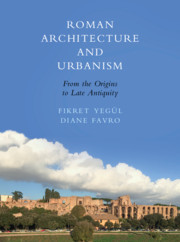Book contents
- Roman Architecture and Urbanism
- Roman Architecture and Urbanism
- Copyright page
- Contents
- Preface and Acknowledgments
- Maps
- Introduction
- 1 Urban Design and Architecture in Rome and Italy during the Republic and the Early Empire
- 2 Temple Architecture of Republican Rome and Italy
- 3 Technology of Building
- 4 Julio-Claudian Architecture in Rome
- 5 Residential Architecture
- 6 Imperial Architecture in Rome from the Flavians through the Antonines
- 7 Architecture and Planning in Italy and the Western Provinces
- 8 Architecture and Planning in North Africa
- 9 Greece under Roman Rule
- 10 Architecture and Planning in Asia Minor
- 11 The Roman Near East
- 12 The Late Empire in Rome and the Provinces
- General Bibliography
- Glossary
- Index
- Plate Section (PDF Only)
- References
1 - Urban Design and Architecture in Rome and Italy during the Republic and the Early Empire
Published online by Cambridge University Press: 21 August 2019
- Roman Architecture and Urbanism
- Roman Architecture and Urbanism
- Copyright page
- Contents
- Preface and Acknowledgments
- Maps
- Introduction
- 1 Urban Design and Architecture in Rome and Italy during the Republic and the Early Empire
- 2 Temple Architecture of Republican Rome and Italy
- 3 Technology of Building
- 4 Julio-Claudian Architecture in Rome
- 5 Residential Architecture
- 6 Imperial Architecture in Rome from the Flavians through the Antonines
- 7 Architecture and Planning in Italy and the Western Provinces
- 8 Architecture and Planning in North Africa
- 9 Greece under Roman Rule
- 10 Architecture and Planning in Asia Minor
- 11 The Roman Near East
- 12 The Late Empire in Rome and the Provinces
- General Bibliography
- Glossary
- Index
- Plate Section (PDF Only)
- References
Summary
In a passage from the sixth century ce, Procopius described the Romans as “the most city proud people known” (Goth. 8.22.7). While their myths, art, and literature reverberated with agrarian associations, from the earliest days the Romans stubbornly, unswervingly associated their achievements with an urban locus. The conquest of Italy and the “subsequent expansion of the empire relied on a system of urban centers for further conquest, defense and administration, and these also participated in the spread of Rome’s version of civilization” (Sewell 2010, 9). The Romans developed elaborate stories to justify the position of their namesake city, citing divine intervention as well as the strategic, economic, and transportation advantages of the site. An island (Insula Tiberina) in the Tiber River allowed traders to easily cross the watery barrier, while the hills to the east offered protection. At the bridgehead on the right bank, markets developed to conduct trade with the Etruscans and numerous tribal groups in central Italy. Yet the site was not perfect (). The hills had sharp scarps and little water; the lowlands were marshy, unhealthy, and flood-prone. Raw materials were few. The unruly Tiber made navigation unpredictable. A heavily laden cart took more than a day to reach the seaside salt beds and port at the sea 25 kilometers away. Early occupants acknowledged that Rome’s placement did not provide the security and ease of access found at other early Italian cities such as Veii and Cuma. And yet it was Rome that came to conquer the world. Why? Common sense dictates that the inland location provided adequate access to the sea by way of the river, while simultaneously offering some protection from potential coastal attacks. Some ancient authors inflated the amenities offered by the site, but Strabo, writing in the first century, presented a different view. He perceptively argued that, established as a matter of necessity rather than of choice, the challenging location molded Roman character by compelling the occupants to reshape the topography, seek accommodation with surrounding peoples, and organize large workforces to create a mighty walled city (Geog. 5.3.2, 7). The valor and toil of the Romans, their pragmatic and focused character seen in veristic Republican portraits, were irrevocably associated with the fixity of the specific urban site. Thus the place and the actions of its residents, rather than the form of the city, forged an inclusive collective identity, a potent strategy at a time when diverse peoples occupied the Italian peninsula. Wars, sacks, and negative comparison with better-situated and “planned” contemporary cities periodically sparked discussions about moving the center of Roman power, yet the locus of the early settlement on the shores of the Tiber, anchored by the practical advantages of the location and bolstered by the emotional attractions of its founding myths, could not be abandoned.
- Type
- Chapter
- Information
- Roman Architecture and UrbanismFrom the Origins to Late Antiquity, pp. 4 - 80Publisher: Cambridge University PressPrint publication year: 2019



